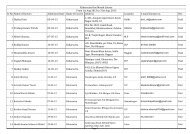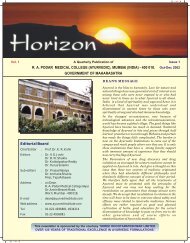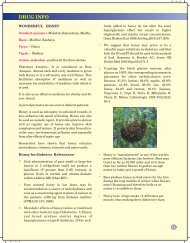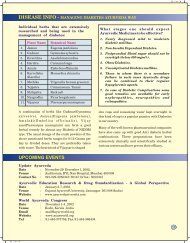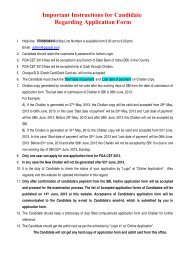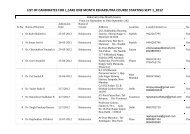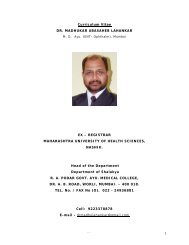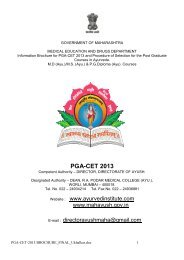Prameha in terms of Diabetes Mellitus, Metabolic syndrome and ...
Prameha in terms of Diabetes Mellitus, Metabolic syndrome and ...
Prameha in terms of Diabetes Mellitus, Metabolic syndrome and ...
- No tags were found...
You also want an ePaper? Increase the reach of your titles
YUMPU automatically turns print PDFs into web optimized ePapers that Google loves.
PRAMEHA IN AYURVEDA, PART 2Box 1. Research <strong>in</strong> Theses, CD-ROM, <strong>and</strong> WebsiteBhatia S, Ch<strong>and</strong>ola HM, S<strong>in</strong>gh G. A cl<strong>in</strong>ical study on the role <strong>of</strong> Manasa Bhava <strong>in</strong> the etiopathogenesis <strong>of</strong> Madhumeha<strong>and</strong> its management by Saraswata Choorna. MD(Ayu) thesis. Institute for Post Graduate Teach<strong>in</strong>g & Research <strong>in</strong>Ayurveda, Gujarat Ayurvcd University, Jamnagar, India, 2001.Plants <strong>of</strong> Ayurveda, version 1.0, CD ROM on Dravyaguna. Sponsored by M<strong>in</strong>istry <strong>of</strong> Environment <strong>and</strong> Forest, Government <strong>of</strong> India (New Delhi) <strong>and</strong> RGUHS (Bangalore). Designed <strong>and</strong> developed by FRLHT (Bangalore), 2005.S<strong>in</strong>gh B, S<strong>in</strong>gh G, Vyas SN, Ch<strong>and</strong>ola HM. The role <strong>of</strong> Virerhana <strong>and</strong> herbal drugs <strong>in</strong> the management <strong>of</strong> Madhumeha(diabetes mellitus). MD(Ayu) thesis. Institute for Post Graduate Teach<strong>in</strong>g <strong>and</strong> Research <strong>in</strong> Ayurveda, Gujarat AyurvedUniversity, Jamnagar, India, 1992.Marvvah B, S<strong>in</strong>gh G, Ch<strong>and</strong>ola HM. A cl<strong>in</strong>ical study on the role <strong>of</strong> certa<strong>in</strong> Ayurvedic drugs <strong>in</strong> management <strong>of</strong>Madhumeha (diabetes mellitus). MD(Ayu) thesis. Institute for Post Graduate Teach<strong>in</strong>g <strong>and</strong> Research <strong>in</strong> Ayurveda, GujaratAyurvcd University, jamnagar, India, 1990.Cl<strong>in</strong>ical Research on-<strong>Diabetes</strong> mellitus, reported on website <strong>of</strong> India's Central Council for Research <strong>in</strong> Ayurveda <strong>and</strong>Siddha. Onl<strong>in</strong>e document at: http://ccras.nic.<strong>in</strong>/Rcsearch_Activities/20081015_diabetes.htm Accessed June 12, 2010.Deka D, Ch<strong>and</strong>ola HM, S<strong>in</strong>gh G. A cl<strong>in</strong>ical study on Klaibya (male sexual dysfunction) <strong>in</strong> Madhumeha <strong>and</strong> Uccharaktachapa<strong>and</strong> its management by Vajikarana Yoga. PhD thesis. Institute for Post Graduate Teach<strong>in</strong>g <strong>and</strong> Research <strong>in</strong>Ayurveda, Gujarat Ayurved University, Jamnagar, India, 2004.Virani N, Ch<strong>and</strong>ola HM, Vyas SN, Jadeja DB. A cl<strong>in</strong>ical study on etiopathogenesis <strong>of</strong> erectile dysfunction (Klaibya) <strong>in</strong>diabetic <strong>and</strong> non-diabetic patients <strong>and</strong> its management with Ashvattha. MD(Ayu) thesis. Institute for Post GraduateTeach<strong>in</strong>g <strong>and</strong> Research <strong>in</strong> Ayurveda, Gujarat Ayurved University, Jamnagar, India, 2009.Dwjvedi KN. KiTect <strong>of</strong> Dashamoola on diabetic neuropathy. MD(Ayu) thesis. Institute <strong>of</strong> Medical Sciences, BanarasH<strong>in</strong>du University, Varanasi, India, 1986.Upadhyaya JM, S<strong>in</strong>gh K. Role <strong>of</strong> Saptamrita Lauha <strong>in</strong> Timira with special reference to myopia. MD(Ayu) thesis,<strong>in</strong>stitute for Post Graduate Teach<strong>in</strong>g <strong>and</strong> Research <strong>in</strong> Ayurveda, Gujarat Ayurved University, Jamnagar, India, 1993.Gupta Durgesh P. A cl<strong>in</strong>ical study on Akshi Tarpana with <strong>and</strong> without Nasya on Timira with special reference tomyopia. MD(Ayu) thesis. Institute for Post Gradviate Teach<strong>in</strong>g <strong>and</strong> Research <strong>in</strong> Ayurveda, Gujarat Ayurved University,Jamnagar, India, 2009.Anil Kumar E, Study on various preparations <strong>of</strong> Manjishthadi Kvatha <strong>and</strong> its effect <strong>in</strong> Tvak Rogas (sk<strong>in</strong> diseases).MD(Ayu) thesis. Government Ayurveda College, Kerala University, Triv<strong>and</strong>rum, India, 1985.Shr<strong>in</strong>gi MK. Therapeutic efficacy <strong>of</strong> leech application, Kaishore Guggulu, <strong>and</strong> Neem oil <strong>in</strong> sk<strong>in</strong> disorders [<strong>in</strong> H<strong>in</strong>di].MD(Ayu) thesis. National Institute <strong>of</strong> Ayurveda, Jaipur, India, 1996.Hota P. A cl<strong>in</strong>ical study on Vatarakta <strong>and</strong> its management with Kaishor Guggulu. MD(Ayu) thesis. Gopab<strong>and</strong>huAyurved Mahavidyalaya, Utkal University, Puri, India, 1997.type 2 diabetes, treatment with G. sylvestr? extract significantly reduced blood glucose, glycosylated hemoglob<strong>in</strong>, <strong>and</strong>glycosylated plasma prote<strong>in</strong>s, whereas with conventionaltreatment alone {i.e., glibenclamide or tolbutamide), thesevalues <strong>in</strong>creased or rema<strong>in</strong>ed the same. The patients receiv<strong>in</strong>g the herbal extract were able to decrease the dosage <strong>of</strong>their conventional drug, <strong>and</strong> 5 patients were able to discont<strong>in</strong>ue the drug entirely <strong>and</strong> ma<strong>in</strong>ta<strong>in</strong> their blood glucoselevels us<strong>in</strong>g only G. si/lvestrc.^ In 27 patients with type 1diabetes, G. sylvestre treatment reduced fast<strong>in</strong>g blood glucose, glycosylated hemoglob<strong>in</strong>, <strong>and</strong> glycosylated plasmaprote<strong>in</strong> levels. Insul<strong>in</strong> requirements decreased <strong>and</strong> serumlipids returned to near normal levels. Patients on <strong>in</strong>sul<strong>in</strong>therapy alone had no significant reduction <strong>in</strong> serum lipids,glycosylated hemoglob<strong>in</strong>, or glycosylated plasma prote<strong>in</strong>s.8SAqueous <strong>and</strong> alcoholic extracts <strong>of</strong> Cuducli't [T<strong>in</strong>ospora cordifolia(Willd.) Hook. f. & Thomson] reduced glucose levels <strong>in</strong>rats with alloxan-mduced diabetes. The antihyperglyccmiceffect may be due to pancreatic islet frec-radical-scaveng<strong>in</strong>gactivity. This herb also lowers the levels <strong>of</strong> tissue <strong>and</strong> serumcholesterol, phospholipids, <strong>and</strong> free fatty acids (Plants <strong>of</strong>Ayurveda, 2005; see Box i).86"89 Kiratatiktn [Swertia chirata(Roxb.) Buch.-Mam.; also known as Swertia chirayita (Roxb.)H. Karst] is a potent antidiabetic herb. In a pilot study,Swertia chirata produced a significant decrease <strong>in</strong> fast<strong>in</strong>g <strong>and</strong>postpr<strong>and</strong>ial blood glucose levels <strong>in</strong> patients with diabetes.81It conta<strong>in</strong>s swerchir<strong>in</strong>, a xanthone found <strong>in</strong> the Swertia species <strong>of</strong> plants. Xanthones are a unique class <strong>of</strong> biologicallyactive compounds with antioxidant properties. Research hasshown swerchir<strong>in</strong> produces a significant decrease <strong>in</strong> bloodglucose levels <strong>in</strong> rat models.'"' y A 60% decrease <strong>in</strong> bloodglucose <strong>in</strong>duced by swerchir<strong>in</strong> was accompanied by amarked depletion <strong>in</strong> /(-granules <strong>and</strong> <strong>in</strong>sul<strong>in</strong> <strong>in</strong> the pancreaticislets. Glucose uptake <strong>and</strong> glycogen synthesis by the diaphragm muscle was significantly enhanced <strong>in</strong> vitro by thescrum <strong>of</strong> swerchir<strong>in</strong>-treated rats. It was therefore concludedthat swerchir<strong>in</strong> lowers blood glucose levels by stimulat<strong>in</strong>g<strong>in</strong>sul<strong>in</strong> release from the islets <strong>of</strong> Langcrhans.9'1Shilajatu (Shilajit, Asphaltnm punjnbianiim) is a res<strong>in</strong>ous,m<strong>in</strong>eral-rich substance with vegetative orig<strong>in</strong>s that is found<strong>in</strong> the Himalayan mounta<strong>in</strong>s. It is recommended for manydiseases, such as Pramcha, Sthau!ya (obesity), Hridroga (heartdisease), <strong>and</strong> so on. It is an established treatment for diabetesthat not only mitigates morbid Kaphn <strong>and</strong> Meda, but also hasrejuvenat<strong>in</strong>g properties.911 In a cl<strong>in</strong>ical study on patients withdiabetes, Shilajit significantly reduced lipid peroxidation <strong>and</strong>significantly <strong>in</strong>creased levels <strong>of</strong> catalase, an antioxidant enzyme.9' In rats with diabftes, Shilajit produced a significantreduction <strong>in</strong> blood glucose levels as well as beneficial effectson the lipid pr<strong>of</strong>ile. Us<strong>in</strong>g Shiiajit <strong>in</strong> comb<strong>in</strong>ation with



